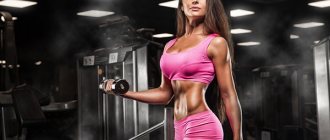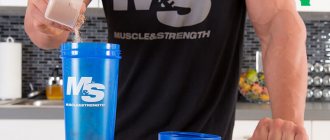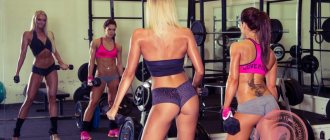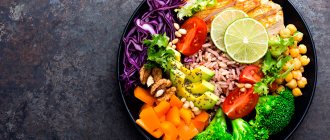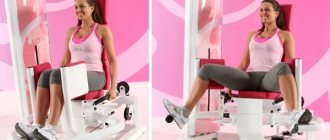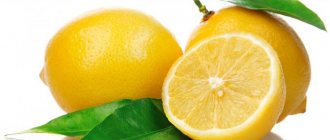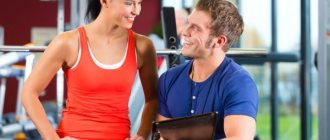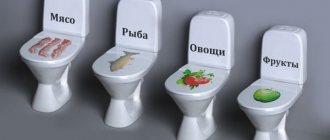Diets
Sergey Sidoruk 03/31/2019 no comments
1
Diet for those involved in fitness
2.9 (58.39%) 186 votes
The main reason for progress in fitness is proper, balanced nutrition. Sleep comes in second place, and physical activity comes only in third place, so you need to approach this issue with the greatest responsibility.
Features of fitness nutrition
Content
Exercise and a healthy diet are the key to a fit figure and a good mood. And if all this happens on a regular basis, then the result will get better and better every day. It’s not as scary to miss a workout because you feel unwell as emptying the refrigerator at night. We will consider the main principles of fitness nutrition for men and women below.
For men
Men need one and a half to two times more calories per day than women. If a man is involved in fitness and strives to adhere to a healthy diet, he will have to follow the basic rules of calorie intake per day. The diet should consist of 30-40 percent protein. Of course, each body has its own characteristics, but to maintain muscle mass and increase it, half of the food per day should consist of proteins and carbohydrates.
The key to a toned figure is exercise and healthy eating.
For women
In the female body, metabolism is slowed down by about 15 percent due to less voluminous muscle mass. Therefore, when drawing up a fitness diet for weight loss for women, it is worth paying attention, in addition to proteins, fats and carbohydrates, to vitamins and minerals. Adding them to your diet has a beneficial effect on maintaining the condition of hair, nails and skin. When creating a fitness diet, you need to take into account all the intricacies of the female body.
How to eat during fitness?
Maintaining a proper diet is the key to effective training. And in order to feel full of strength, it is best to follow some simple recommendations:
- You should never exercise on an empty stomach. You will quickly feel tired, and then you will feel hungry and think about food rather than training.
- A few hours before exercise is best to consume carbohydrates. This will allow you to recharge with the necessary energy.
- If you want to gain muscle mass, then after fitness you need to eat fruit. You can drink juice or snack on chocolate. This will allow you to replenish your energy, and after half an hour you can start eating a full meal.
But you need to remember that for proper metabolism and a slim figure, it is best to have your last snack no later than 2-3 hours before bedtime.
Products in the fitness menu
We have sorted out the priorities and differences in the bodies of men and women. It remains to determine which products are suitable for a fitness diet for burning fat, and which will interfere with the active process of losing weight.
Squirrels
Proteins are compounds that are the main “builder” of our body. For a person involved in fitness, the daily protein requirement is calculated according to the following principle: 1.5 g per 1 kg of body weight. But you shouldn’t consume more than 30 g per meal (most likely, protein beyond this norm will simply not be absorbed).
Rules for healthy eating when doing fitness
Preparation
With a normal lifestyle, the body consumes 2-3 liters of water daily. During intense physical activity, more fluid is required; lack of proper attention to this feature can lead to dehydration. Therefore, before training, it is useful to drink 0.5-0.6 liters of water (still) 1-2 hours before training. It is also advisable to take water with you to training. Additional fluid allows you to more effectively remove toxins and metabolic products, the production of which becomes more intense due to accelerated metabolism. In addition, it is useful to enrich your diet on training days with foods containing catechins: berries, fruits, green tea, cocoa beans. Catechins help fight excess calories by regulating blood sugar levels, having antioxidant activity and helping to increase energy expenditure and speed up metabolism.
Meals on the day of training, if it is planned for the early hours, should be light: it is good to eat muesli with yogurt or drink tea with honey.
During the day, you can eat 2-3 hours in advance, including legumes or cereals (the content of complex carbohydrates should be approximately 50-100 g) and 100-150 g of seafood or lean chicken. Don't neglect food completely: fasting lowers sugar levels and also slows down metabolism, which negatively affects the effectiveness of your workouts. During training
Intense physical exercise is an additional stress for the body. Already during the warm-up, he begins to readjust to active activity, and resources are mobilized.
- The source of energy for muscles is glycogen. It is intensively consumed during training. In addition, as a result of the activation of metabolic processes, lactic acid accumulates in the muscles, which interferes with their contraction and creates pain after exercise. Need: remove acid from the body
- To obtain energy, the body first begins to use carbohydrates, then fats. It is at this moment of training that the feeling of hunger appears. Do: Avoid any food intake for at least an hour after finishing your workout.
- Actively working muscles require additional oxygen and nutrition. Need: provide the muscles with substances in the required quantities.
- Intense sweating leads to blood thickening. It is necessary: to prevent the possible occurrence of blood clots.
During training, pay close attention to possible signs of dehydration: headache, dizziness, dry mouth.
In the future, this can lead to general weakness, increased fatigue, and loss of activity. Therefore, when the first symptoms of dehydration appear, you should immediately start drinking water. To do this, interrupt your training until the condition returns to normal. Approximate volume of water for a person weighing 60-75 kg: 100-150 ml per 10-15 minutes. More intense loads require more fluid; it is also useful to use not pure water, but special isotonic drinks that contain vitamins, microelements and carbohydrates. Eating during training, on the contrary, is undesirable. Only if the duration of the workout is more than 2 hours, you should eat a little dried fruit. After training
The main tasks of this period are to restore the normal rhythm of the heartbeat and remove accumulated toxins resulting from muscle activity from the body as quickly as possible.
This requires additional liquid. In addition, you need to “return” to the body the beneficial microelements and vitamins that came out with sweat during training. Drink a glass of freshly squeezed apple or carrot juice half an hour after exercise, this will also help restore energy. An hour after class it is time to eat. What is the best thing to eat after a workout? In the first half of the day, for those who want to lose weight, a green salad and boiled salmon are suitable, and for those who are working on gaining muscle mass, grilled chicken breast and 100 g of rice are suitable. In the afternoon, you can limit yourself to 100-150 g of low-fat cottage cheese or 1-2 glasses of low-fat kefir. Other recovery methods Walking. In order to calm the pulse and bring it to 60-80 beats, it is useful to walk a little quietly, preferably in the fresh air. This allows you to prolong the breakdown of fats and also provide the body with additional oxygen. When walking, the muscles return to normal operation within 10 minutes. The general recommended duration of the walk is 30-40 minutes. Pool. Helps restore the thermoregulation system and muscle tissue, remove lactic acid, and create additional aerobic exercise. Immediately after training, it is useful to swim for 15-20 minutes. Bathhouse. Helps strengthen the immune system, improve the condition of ligaments and joints. On the other hand, the sauna creates additional stress on the thermoregulation system and the heart; it should be used with caution, especially after intense training. Recommended regimen: 2-3 sessions, from 5 to 15 minutes each; after high loads, it is better to limit yourself to one 5-minute session. I WANT TO LOSE WEIGHT IN 30 days
Fitness menu
Strength training
The main task is to provide the body with a sufficient amount of necessary substances. Protein intake should be at least 1.2-1.6 g per 1 kg of body weight, carbohydrates - 3-4 g, fat - 0.7-0.8 g. Recommended amount of calories - 34-36 kcal per 1 kg body weight. Directly on the day of training, it is better to avoid fried foods, saturated fats and simple carbohydrates. Those who want to lose weight can eat a salad of fresh vegetables (200 g), those who build muscle mass can eat lean pork or chicken (200 g).
Cardio training
A significant increase in the volume of carbohydrates and a decrease in the volume of proteins is necessary. Carbohydrates should be up to 5-6 g per 1 kg of body weight, proteins - 0.8-1 g. Be sure to drink water directly during exercise, preferably an isotonic drink. For those who want to lose weight, you can use the same ratio of fat, protein and carbohydrates as in the case of strength training, but at the same time reduce the caloric content of food to 26-30 kcal. The ideal pre-cardio meal is cereal with low-calorie kefir. Another option is stewed vegetables and rice, 100g each.
Yoga and Pilates
Nutrition should be balanced: for every gram of protein - 0.8 g of fat, 4 g of carbohydrates. Energy value: 30-34 kcal. We recommend foods containing fibrous carbohydrates - vegetables and herbs. It is better to exclude smoked meats, fatty meats, and fish. Vegetable stew, tomato soup with spinach and rice, a fresh vegetable salad or a glass of low-fat milk will give you a good mood for class.
Sample menu for the week
An example of a balanced diet for a week, taking into account meals before and after fitness. Meals are divided into 5 meals, taking into account the daily calorie intake.
1 day:
- 2 eggs, a glass of juice, oatmeal and cottage cheese;
- fruit salad;
- cucumber and tomato salad, boiled turkey with rice;
- kefir with bran bread;
- vegetable salad, fish or seafood.
Day 2:
- kefir with fruits;
- carrot and cabbage salad, meat;
- omelet, cabbage salad, vegetable broth soup;
- apple;
- salad with herbs and vegetables, oatmeal.
Day 3:
- banana, kefir, oatmeal;
- cottage cheese with fruit;
- boiled chicken breast with buckwheat;
- vegetable juice, apple;
- baked beef with vegetable salad.
For a balanced diet, meals are divided into 5 meals
Day 4:
- 2 eggs, oatmeal, banana;
- juice with bran bread;
- boiled beef with rice porridge;
- cottage cheese with fruit;
- chicken breast with vegetables.
Day 5:
- muesli with milk, apple;
- fruit salad;
- chicken meat with buckwheat, apple;
- low-fat yogurt with bread;
- baked fish with vegetables.
Day 6:
- buckwheat with milk, banana;
- cottage cheese with dried fruits;
- baked fish with rice and vegetables;
- kefir with bread;
- boiled seafood with vegetables.
Menu for a balanced diet
Day 7
- 2 eggs, oatmeal with fruit;
- cottage cheese with banana;
- chicken breast with rice, several tomatoes;
- yogurt, apple;
- beef with boiled corn.
Dish recipes
How to continue to eat deliciously, but without gaining extra pounds? Recipes for low-calorie dietary dishes that can easily be prepared at home will help in this matter.
First meal
Vegetable soup with celery
Ingredients:
- celery root – 1 pc.;
- white cabbage – 0.5 kg;
- onions – 300 g;
- tomatoes –0.5 kg;
- sweet pepper – 3 pcs.;
- green onions - 2-3 feathers;
- head of garlic;
- spices, herbs and olive oil - to taste.
Vegetable soup with celery
Fry the chopped onion until golden brown. Add grated carrots and celery. Add the cabbage and sweet pepper there and mix. Simmer for 10 minutes, add tomatoes and leave to simmer for a few more minutes.
Place the vegetables in a saucepan and pour boiling water over them, covering them completely with the water level. After boiling, stir and leave for another 10 minutes. Add herbs, garlic and spices to taste. Let's leave it to brew.
Lentil soup
Ingredients:
- vegetable broth – 1 l;
- onions – 1 pc.;
- carrots – 1 pc.;
- lentils – 200 g;
- 1 head of garlic;
- herbs and spices - to taste.
Chop onion, garlic, carrots and herbs. Bring the vegetable broth to a boil and lower the onions and carrots into it. We wait 10 minutes, then add the lentils and continue cooking until they are ready.
A few minutes before removing from heat, add spices, garlic and herbs to taste.
Lentil soup
Second courses
Chicken breast with funchose
Ingredients:
- chicken fillet – 200-300 g;
- carrots – 1 pc.;
- onion – 1 pc.;
- dried porcini mushrooms – 1-2 handfuls;
- funchose (glass noodles) – 150-200 g;
- sugar – 1 tsp;
- soy sauce – 5 tbsp. l.
Fry the onion with added sugar until transparent. We also send grated carrots and garlic there. Keep it on for a couple more minutes. Place chopped chicken breast. After 5-8 minutes, add mushrooms and soy sauce. Simmer for 5 minutes, then mix with funcheza, which we first soak in boiling water for 4-6 minutes. Stir and heat our dish.
Hake in a slow cooker
Ingredients:
- medium hake – 3 pcs.;
- carrots – 1 pc.;
- onion – 1 pc.;
- lemon - half;
- bay leaf, salt and spices - at your discretion.
Let's cut the hake into the required portions. Sprinkle with lemon juice and add salt and pepper to taste. Place the onion, chopped into rings, grated carrots and fish into the multicooker. Add water and cook in fish mode for 7-10 minutes.
Main courses for a fitness diet
Losing weight can be delicious. Protein diet for women and men
For those people for whom sport is not just watching competitions on TV, a protein diet will help. This technique is based on the following principles:
- fractional meal regimen;
- maintaining water balance;
- refusal to eat after 20 hours;
- using only olive oil for dressing salads and frying foods;
- Since familiar foods are prohibited, you need to take multivitamin complexes.
Advantages
The main advantage of a protein diet is rapid weight loss that does not lead to sagging skin. This principle of healthy eating and sports are quite compatible, since it provokes fat burning while simultaneously restoring metabolic processes. Thanks to the easy preparation of most dishes, a person is constantly full, it is easy for him to diversify his diet, enjoying delicious foods.
Flaws
Nutritionists warn that not everyone is allowed to use a protein diet. It is better not to use it for pregnant and breastfeeding women, diabetics, and those with liver, kidney and gastrointestinal problems. Also, this diet is not suitable for minors, since their bodies require vitamins to ensure proper development of the body.
What you can and cannot eat
Authorized products:
- still mineral water, tea, unsweetened coffee;
- vegetables (it’s not advisable to get carried away with zucchini or eggplant);
- mushrooms;
- maximum 4 eggs per week;
- meat products, poultry, any fish;
- olive oil;
- garlic and all spices;
- lemons.
Prohibited products:
- alcohol;
- fruit juices and all fruits;
- canned drinks;
- seafood, seaweed;
- legumes and cereals;
- nuts or seeds;
- vegetables in marinade;
- carrots, potatoes, beets with corn;
- all canned food;
- sweet pastries;
- sausages (except boiled types) and smoked meats;
- fermented milk products and milk.
Use of sports supplements in fitness
Taking sports nutrition is an addition to the main diet and in no case can replace a full meal. Supplements are not doping, steroids and do not harm the human body. An undoubted advantage of taking supplements is the replenishment of missing elements before, during and after fitness classes.
The only downside is their high cost.
Let’s take a closer look at what sports nutrition and supplements should be consumed when doing fitness.
Protein
Pure protein. Ideal to take before your morning run or during and immediately after exercise to satisfy hunger and fuel muscles. The protein is sold in powder form, which is easily diluted with water or milk.
BCAAs
The same protein, only split into elements. It differs from protein in that it contains only 3 amino acids, but the ones that most influence the growth of muscle mass and the maintenance of tissue condition. Also, these amino acids are essential and cannot be synthesized in the human body. BCAA's are available in capsule form.
Sports nutrition is a supplement to the main diet.
L-carnitine
Causes a fat burning effect due to the breakdown of fat tissue during cardio exercise. The most suitable type of sports supplement for fitness. L-carnitine is available in powder and capsule form.
Daily vitamins
They represent the entire list of vitamins and minerals necessary for humans. Recommended for all people, even those not involved in sports. Available in the form of compressed tablets.
Common Fitness Stereotypes
There are some stereotypes about fitness that can scare a person away from exercising. Let's look at the most common ones and try to destroy them!
It is inappropriate and dangerous for girls to exercise in the gym.
A large number of girls are sure that they have nothing to do in the gym, and training with free weights will turn them into muscle women. But this is not true at all. All modern gyms are equipped with equipment for pumping and improving lagging muscles. Ellipticals, step machines and treadmills are the perfect start and end to every workout.
There are some stereotypes about fitness for women
If you stop exercising, your muscles will turn into fat.
It's not like that at all. When you pause or stop exercising for various reasons, muscle mass may simply decrease in size, because the body does not need it without stress. And if there were extra pounds initially, they will not return on their own. It all depends on whether you follow your diet and sleep schedule outside of the training process or not.
Fitness takes too much time.
Another misconception. A well-designed fitness training plan lasts approximately 40-60 minutes and takes 10 minutes each to warm up and cool down. Therefore, you can always take an hour of time for your own beauty and health.
How to eat right to lose weight
To begin, follow the general principles of composition and intake of food for weight loss:
- Make your diet varied . To get rid of excess fat through exercise, creating a calorie deficit is unnecessary and even harmful. The menu should be balanced and the stomach should be moderately full.
- Have meals 5 times a day - 3 main meals and 2 snacks . It is optimal to eat 30% of your daily calorie intake for breakfast, 35% for lunch, 25% for dinner and 10% for snacks.
- Keep track of your balance. The amount of concrete products must correspond to the needs of the body. A nutritionist can help you figure them out – it’s individual.
A sports diet for weight loss involves taking additional “doping”, which can be selected by a specialist (vitamin complex, amino acids, protein and fat burners).
